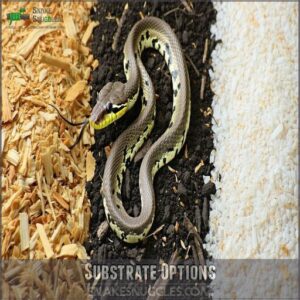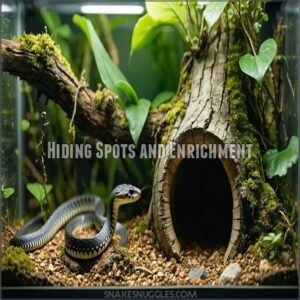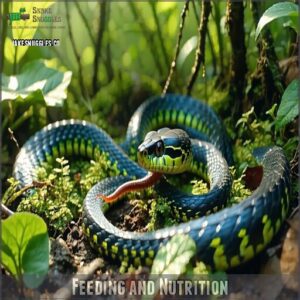This site is supported by our readers. We may earn a commission, at no cost to you, if you purchase through links.

Use a secure, spacious enclosure with a well-ventilated lid, and line it with safe substrate like aspen shavings or paper towels.
Add hiding spots for security, a shallow water dish, and a basking area around 85°F while keeping the cool side at 70-75°F.
They need fresh water daily and can eat small fish, worms, or thawed pinky mice—just avoid anything too big.
Watch for signs of illness like labored breathing or poor shedding.
With the right balance, your garter snake will thrive.
Curious about lighting or diet details?
Table Of Contents
- Key Takeaways
- Garter Snake Habitat
- Temperature Gradient Setup
- Lighting Requirements
- Feeding and Nutrition
- Health and Maintenance
- Frequently Asked Questions (FAQs)
- How to care for a garter snake for beginners?
- Is it okay to keep a wild garter snake as a pet?
- Are garter snakes high maintenance?
- What is the best bedding for garter snakes?
- How long do garter snakes live in captivity?
- How to make a garter snake habitat?
- Are garter snakes easy to care for?
- How many gallons does a garter snake need?
- What is a garter snake care sheet?
- How do you handle a garter snake?
- Conclusion
Key Takeaways
- You’ll need a secure enclosure with proper ventilation, safe substrate like aspen shavings, multiple hiding spots, and a water dish to create an ideal garter snake habitat.
- Maintain a temperature gradient with a basking area of 85-90°F and a cool side of 75-80°F, using appropriate heating equipment like heat lamps or ceramic emitters (avoid heat rocks).
- Feed your garter snake appropriately sized prey like small fish, worms, or thawed pinky mice, adjusting frequency based on age (more often for juveniles, every 5-7 days for adults).
- Monitor your snake’s health by watching for signs like alert behavior, regular shedding, and clear eyes, while maintaining proper humidity (35-60%) to prevent respiratory infections and shedding problems.
Garter Snake Habitat
Creating the perfect habitat for your garter snake is essential to keeping it healthy and active.
The key to a thriving garter snake is a habitat that mimics nature, balancing comfort, enrichment, and essential care.
From enclosure size to humidity control, every detail matters to mimic their natural environment and meet their needs, including complete concepts such as these.
Enclosure Size and Type
A garter snake enclosure should fit their active nature.
The minimum size is one equal to the snake’s total length plus its width.
Glass vs. plastic? Both work, but secure lids are essential—these snakes are escape artists!
Prefer a naturalistic vivarium setup? Group housing can work in larger tanks, but provide sufficient hiding spots to avoid stress.
Consider that proper humidity level maintenance is essential for healthy shedding.
Substrate Options
Choosing the right garter snake substrate guarantees comfort and safety.
Popular choices include:
| Substrate Type | Advantages | Considerations |
|---|---|---|
| Aspen Shavings | Allows digging behavior | Needs regular cleaning for odor control |
| Coconut Fiber | Retains substrate moisture | May mold if overly damp |
| Paper Towels | Easy to clean | Lacks natural appearance |
Avoid unsafe options like pine or cedar.
You can find options for garter snake bedding online, which is essential for maintaining a healthy environment and ensuring the safety of your pet.
Hiding Spots and Enrichment
In your garter snake enclosure, hiding places and enrichment keep your snake active and stress-free.
Variety is key—provide spots to retreat and explore. You can find various enclosure hides to promote security.
- Substrate Enrichment: Layers of leaves or coconut husk for burrowing.
- Climbing Structures: Branches or vines for sensory stimulation and exercise.
- Enrichment Toys: Puzzle feeders or small hides add variety to daily activities.
Water Sources and Humidity Control
A shallow water bowl is a must for your snake’s hydration and as a shedding aid.
Keep water quality high by changing it daily.
Maintain snake humidity requirements (35-60%) with misting systems or damp moss hides.
Accurate snake humidity control supports healthy shedding.
Balance humidity levels carefully to avoid issues with garter snake humidity or over-moist environments.
Temperature Gradient Setup
Creating the right temperature gradient in your garter snake’s enclosure is essential for their health and comfort.
By arranging warm and cool zones, you let your snake thermoregulate naturally, just like they’d in the wild.
Basking Area Setup
A proper basking area is key for garter snake care.
Place the basking lamp over a branch or stone where your snake can soak up heat and UV exposure.
Choose sturdy basking branch materials like driftwood or cork bark.
Maintain the basking site at 85-90°F, monitored with a thermostat.
Correct basking spot placement guarantees a healthy temperature gradient.
Cool Side Temperature Management
Managing the cool side’s temperature is essential for a healthy snake temperature gradient.
Keep it at 75-80°F.
Use a digital thermometer for accurate monitoring.
Guarantee consistency by placing the heat source away from this area.
Here’s how:
- Use a thermometer at ground level for precise readings.
- Regulate temperature with proper ventilation.
- Avoid direct heat impact on the cool side.
Nighttime Temperature Considerations
At night, garter snakes require cooler temperatures to mimic natural conditions. Temperatures should drop to 64-75°F, based on species and season.
Use a thermostat to control nighttime heat sources like ceramic heaters. Monitor night temps with a digital thermometer.
Proper temperature gradients are key for reptile health. Seasonal adjustments are key for garter snake care—too much heat disrupts their temperature requirements.
Follow this snake temperature guide for healthy habits.
| Element | Nighttime Range | Tools Needed | Importance |
|---|---|---|---|
| Temperature Range | 64-75°F | Thermostat | Prevents overheating and promotes comfort |
| Heat Source | Ceramic Heater | Digital Thermometer | Stable, safe heating |
| Monitoring Devices | Thermometer Probe | Hygrometer | Guarantees precise control |
| Seasonal Adjustments | Adjust Temperature | Reflects natural cycles |
Heating Equipment Options
Heating equipment is essential for keeping your garter snake cozy and healthy.
Use heat sources suited to their needs, like:
- Heat Lamps: Choose the right wattage for a basking spot at 85-90°F.
- Ceramic Heat Emitters: Ideal for nighttime heating.
- Under Tank Heaters: Great for belly warmth, but use a thermostat.
- Avoid Heat Rocks: They can cause burns.
Maintaining proper snake warmth is vital for their well-being.
Lighting Requirements
Proper lighting is essential for your garter snake’s health, helping regulate their activity and well-being.
You’ll need a setup that balances UVB exposure, visible light, and consistent day-night cycles.
UVB Lighting Importance
UVB lighting is essential for garter snake care, supporting D3 synthesis, which aids calcium absorption and prevents bone issues.
Mimicking wild behavior, UVB benefits your snake’s health and activity, and it is crucial to choose a bulb matching snake UVB requirements, ensuring proper placement within the lighting spectrum.
Position it 9-12 inches above basking spots for effective exposure that aligns with snake lighting requirements, supporting overall health through UVB benefits and proper calcium absorption.
Day/Night Cycle Simulation
Creating a day/night cycle for your garter snake is key to its well-being.
Use smart timers to set consistent light cycle lengths, mimicking natural seasonal adjustments. Light intensity and UVB impact matter too, so verify proper bulb placement.
- Set 14 hours of light in summer, 10 in winter.
- Adjust gradually for seasonal shifts.
- Timers simplify garter snake lighting schedules.
Visible Light for Plant Growth
When managing garter snake lighting, adding a T5 HO fluorescent grow light replicates the Diurnal Spectrum needed for photosynthesis.
This supports live plant health while balancing light intensity to prevent algae growth.
Proper snake lighting creates a natural environment, benefiting garter snake care and plant life.
Healthy plants reduce stress, enhancing your snake’s habitat beautifully, which is essential for garter snake care.
Seasonal Lighting Adjustments
As seasons shift, match your garter snake’s environment to natural rhythms.
Extend Summer Lighting to mimic longer days, keeping UVB active for 14 hours daily. In Winter Lighting, shorten Light Cycles to 10 hours, as nights lengthen.
Proper lighting replicates natural sunlight, supporting temperature and humidity regulation. Seasonal adjustments keep your snake thriving, aligned with its natural instincts, and overall well-being.
Feeding and Nutrition
Feeding your garter snake a balanced diet is essential for its health and energy. Understanding appropriate prey, portion sizes, and feeding schedules will keep your snake thriving.
Balanced feeding keeps your garter snake thriving, energized, and healthy—matching prey size and schedule matters for optimal care.
Appropriate Prey Items
A balanced garter snake diet includes varied prey like pinkies, small mice, and fish.
Stick to frozen-thawed options to avoid parasites.
Verify that prey size matches the snake’s width, preventing choking.
Occasionally include items like chicken hearts or worms for food variety.
Avoid wild-caught food—it can carry risks.
Balanced feeding keeps your garter snake active, growing, and thriving.
Feeding Frequency by Age
Baby garter snakes should eat small prey every other day, a schedule called Hatchling Feeding.
Juvenile Feeding works well every 2-3 days.
Adult garter snake feeding frequency slows to once every 5-7 days.
Adjust for seasonal changes like cooler months when they eat less.
Always provide prey size matching your snake’s body width to guarantee safe digestion.
Live Vs. Frozen/Thawed Food
Feeding garter snakes involves choosing between live food and frozen options.
Live food risks include potential injuries, while frozen food offers safety and consistent nutritional value.
Proper thawing techniques guarantee frozen prey matches natural feeding. Prekilled prey reduces harm and still satisfies feeding frequency needs.
Always select appropriately-sized garter snake food to promote health and ease feeding stress. Frozen options also eliminate live prey’s bite risk.
Nutritional Supplements
When feeding garter snakes, calcium sources and Vitamin D3 are key to preventing nutritional deficiencies.
Use a multivitamin weekly, lightly dusting prey to support gut health and overall well-being.
Snake supplements are like insurance—they fill gaps in diets, and following a supplement schedule is crucial: calcium every other feeding, and a multivitamin once weekly.
Balanced nutrition means better garter snake care, and by doing so, you ensure better overall health for your pet.
Health and Maintenance
Keeping your garter snake healthy requires regular observation and proper care to address potential issues early.
By learning the signs of illness and knowing how to maintain their well-being, you’ll guarantee a long, active life for your pet.
Signs of a Healthy Garter Snake
A healthy garter snake shows clear signs that you can easily spot.
Look for these key indicators to monitor snake health:
- Alert behavior and an active tongue flicking frequently.
- Regular shedding in one piece, with a smooth, hydrated appearance.
- Clear eyes and smooth scales, free from discoloration or damage.
Consistent snake health relies on close observation of these traits.
Respiratory Infections
Respiratory infections (RI) in garter snakes often show symptoms like wheezing, mouth gaping, or excess mucus.
Improper humidity levels can contribute, so maintaining balanced humidity is key. Treatment options include increasing warmth and seeking veterinary care.
Preventative measures, like consistent enclosure cleaning and proper reptile care, substantially reduce risks. Always prioritize snake health by addressing concerns promptly with professional snake veterinary care when needed, to ensure the best possible outcome for reptile health.
Parasites and Their Treatment
Snake parasites, like internal and external varieties, can harm your garter snake’s health.
To protect them:
- Quarantine Protocol: Isolate new snakes for 8 weeks to prevent disease spread.
- Preventative Measures: Avoid feeding frogs that may carry parasites.
- Veterinary Care: Regular checkups guarantee quick treatment for snake diseases.
- Clean Environment: Remove feces promptly to reduce parasite risks.
Focus on reptile health! To identify potential problems, understand snake parasite types.
Shedding Problems and Solutions
Peeling isn’t always smooth for your garter snake.
If stuck shed appears, check humidity levels—35-60% is ideal.
Use shedding aids like a damp towel rub or a humid hide.
Persistent eye caps may require vet help.
Preventative care includes maintaining proper hydration and temperature.
Garter snake shedding reflects snake health, so watch for shedding skin issues in your snake care guide, focusing on preventative care.
Frequently Asked Questions (FAQs)
How to care for a garter snake for beginners?
Did you know garter snakes can live over 10 years in captivity?
Provide a secure, escape-proof tank, maintain a temperature gradient (75-85°F), and offer hiding spots, UVB lighting, fresh water, and varied food, which includes complete concepts such as a temperature gradient and hiding spots.
Is it okay to keep a wild garter snake as a pet?
Yes, but it’s better to choose a captive-bred garter snake.
Wild snakes often carry parasites, struggle to adjust to captivity, and removing them may harm local ecosystems.
Always research and prioritize ethical pet choices.
Are garter snakes high maintenance?
Garter snakes aren’t high maintenance, but they need proper care.
With a secure enclosure, the right temperature, and a balanced diet, they thrive easily.
Their curious, low-key nature makes them manageable even for beginners.
What is the best bedding for garter snakes?
Think of bedding as your snake’s cozy carpet.
Aspen shavings, cypress mulch, or coconut husk work great.
Avoid cedar and pine—they’re toxic.
Keep it dry, soft, and easy to spot clean for their comfort.
How long do garter snakes live in captivity?
In captivity, garter snakes can live over 10 years with proper care, sometimes reaching 15 years.
A healthy diet, clean environment, and consistent handling can greatly boost their lifespan compared to their wild counterparts.
How to make a garter snake habitat?
Set up a secure enclosure that’s escape-proof and spacious.
Add a warm basking area (85-90°F), cool side (75-80°F), climbing branches, hiding spots, and a water dish.
Keep humidity at 35-60% and ensure the enclosure includes a warm basking area.
Are garter snakes easy to care for?
Yes, they’re fairly easy to care for!
With proper housing, a simple diet of fish or worms, and basic temperature needs, they thrive.
Their curious nature and active behavior make them engaging pets.
How many gallons does a garter snake need?
A garter snake’s tank size depends on its age and size.
Hatchlings need 5-10 gallon tanks, while adults thrive in 20-40 gallon enclosures.
Always make certain the setup is spacious, secure, and escape-proof.
What is a garter snake care sheet?
It’s fascinating how easy caring for garter snakes can be!
You’ll need a snug, escape-proof tank, proper heating, UVB lighting, humidity control, and a balanced diet.
Keep their environment clean, enriched, and secure!
How do you handle a garter snake?
Always approach calmly, supporting its entire body with both hands.
Let it explore your fingers, avoiding sudden movements.
Handle gently and briefly to prevent stress, as garter snakes are active and easily startled.
Conclusion
Caring for a garter snake might feel like a big task at first, but once you’ve mastered the essentials—like habitat setup, temperature control, and diet—it’s straightforward and rewarding.
With the right enclosure, fresh water, and a balanced diet, your snake can thrive in a healthy, stress-free environment.
Regularly monitor their health and behavior, making adjustments as needed, to guarantee your pet lives a long, happy life with you, by following this snake care guide for garter snakes.
- https://www.zenhabitats.com/collections/zen-habitats-reptile-enclosures?filter.p.m.my_fields.material=PVC+%280-100%25+humidity%29&aff=5
- https://www.reptilebasics.com/arcadia-forest-6-uvb/arcadia-d3-6-uvb-t5-bulb-22/
- https://www.facebook.com/AllansPetCenter/posts/1013786421965842
- https://www.cornsnakes.com/forums/threads/parasitic-diseases-of-snakes.5710/
- https://www.dvm360.com/view/common-parasitic-diseases-reptiles-amphibians-proceedings

















